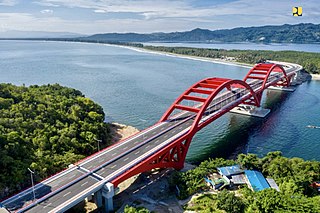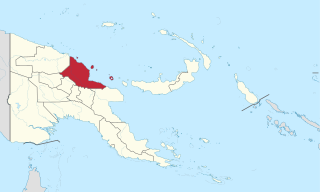
Papua New Guinea, officially the Independent State of Papua New Guinea, is a country in Oceania that comprises the eastern half of the island of New Guinea and its offshore islands in Melanesia. Its capital, located along its southeastern coast, is Port Moresby. The country is the world's third largest island country, with an area of 462,840 km2 (178,700 sq mi).

Port Moresby, also referred to as Pom City or simply Moresby, is the capital and largest city of Papua New Guinea. It is one of the largest cities in the southwestern Pacific outside of Australia and New Zealand. It is located on the shores of the Gulf of Papua, on the south-western coast of the Papuan Peninsula of the island of New Guinea. The city emerged as a trade centre in the second half of the 19th century. During World War II, it was a prime objective for conquest by the Imperial Japanese forces during 1942–43 as a staging point and air base to cut off Australia from Southeast Asia and the Americas.

Jayapura is the capital and largest city of the Indonesian province of Papua. It is situated on the northern coast of New Guinea island and covers an area of 940.0 km2 (362.9 sq mi). The city borders the Pacific Ocean and Yos Sudarso Bay to the north, the sovereign state of Papua New Guinea to the east, Keerom Regency to the south, and Jayapura Regency to the west.

The Territory of Papua comprised the southeastern quarter of the island of New Guinea from 1883 to 1975. In 1883, the Government of Queensland annexed this territory for the British Empire. The United Kingdom Government refused to ratify the annexation but in 1884 a protectorate was proclaimed over the territory, then called "British New Guinea". There is a certain ambiguity about the exact date on which the entire territory was annexed by the British. The Papua Act 1905 recites that this happened "on or about" 4 September 1888. On 18 March 1902, the Territory was placed under the authority of the Commonwealth of Australia. Resolutions of acceptance were passed by the Commonwealth Parliament, which accepted the territory under the name of Papua.

Madang is a province of Papua New Guinea. The province is on the northern coast of mainland Papua New Guinea and has many of the country's highest peaks, active volcanoes and its biggest mix of languages. The capital is the town of Madang.

Central Province is a province in Papua New Guinea located on the southern coast of the country. It has a population of 237,016 people and is 29,998 square kilometres (11,582 sq mi) in size. The seat of government of Central Province, which is located within the National Capital District outside the province, is the Port Moresby suburb of Konedobu. On 9 October 2007, the Central Province government announced plans to build a new provincial capital city at Bautama, which lies within Central Province near Port Moresby, although there has been little progress in constructing it.

The University of Papua New Guinea (UPNG) is a university located in Port Moresby, capital of Papua New Guinea. It was established by ordinance of the Australian administration in 1965. This followed the Currie Commission which had enquired into higher education in Papua New Guinea. The University of Papua New Guinea Act No. 18, 1983 bill repealing the old Ordinance was passed by the National Parliament in August 1983.

The Motu are native inhabitants of Papua New Guinea, living along the southern coastal area of the country. Their indigenous language is also known as Motu, and like several other languages of the region is an Austronesian language. They and the Koitabu people are the original inhabitants and owners of the land on which Port Moresby — the national capital city — stands. The largest Motu village is Hanuabada, northwest of Port Moresby.

The Supreme Court of Papua New Guinea has been the highest court of Papua New Guinea since 16 September 1975, replacing the pre-Independence Supreme Court and the overseas appellate tribunals from 1902 to 1975 of the High Court of Australia and the Judicial Committee of the Privy Council. Judges of the pre-Independence Supreme Court automatically became the first justices of the National Court and accordingly among the pool of judges that were available to be empanelled as a Supreme Court bench.

Papua New Guinea has 326 local-level governments (LLGs) comprising 6,112 wards as of 2018.

The following outline is provided as an overview of and topical guide to Papua New Guinea:

The Royal Papua New Guinea Constabulary (RPNGC) is a national police force with jurisdiction throughout all of Papua New Guinea.

Ela Beach, formerly known as Era Kone, meaning 'Turtle Beach' in the Motuan dialect of the Papuan region of Papua New Guinea, is Port Moresby's primary public beach.
Pinu is a village on the coastline of Western Central Province, Papua New Guinea. The village is accessible by Hiritano highway. Before the construction of the highway, villagers used dugout canoes with sails to travel to and from Port Moresby. Pinu village is located between Aroa River and the Gallery Reach, and has access to food supply from the rivers, swamps, and the sea, as well as gardens and wild game from the plains. Hunting yields wallabies and wild pigs, while seasonal fishing yields fish, crabs, prawns, and shellfish. The surplus is usually sold in the city markets for goods such as sugar, tea, rice, flour, and other staples. There is no cash crop, but informal sales of coconut, betel nut, and other tree species such as eaglewood.
Vabukori is a Motu Koitabu coastal village located in the Moresby South electorate of Port Moresby, the capital city of Papua New Guinea. Vabukori is one of the of villages in Central Province that speaks traditional Motu language along with other villages like Hanuabada and Porebada.
Koitabu, or Koita, is a Papuan language of Papua New Guinea in the Port Moresby area.

Jiwaka is a province of Papua New Guinea. The government gazetted provincial capital is located in Kurumul. Temporarily all provincial matters are handled in Minj after the election of the new Governor in 2022 general elections. Matters concerning each district are dealt with at their respective district administration office.
Robert Agarobe is a Papua New Guinea businessman and politician. He was the Governor of Central Province and a Member of the National Parliament of Papua New Guinea, but was unseated by Rufina Peter in the 2022 Papua New Guinean general election.
Dadi Toka Jr is a Papua New Guinean businessman and the Chairman of the Motu Koita Assembly, a traditional landowner representative group established as an Assembly by an act of the Parliament of Papua New Guinea. The Chairman of the Motu Koita Assembly is also Deputy Governor of National Capital District, which was established on the lands of the Motu and Koitabu people.
Lohia Boe Samuel is a Papua New Guinean Member of Parliament, representing the constituency of Moresby North-West surrounding the nation's capital, Port Moresby.












